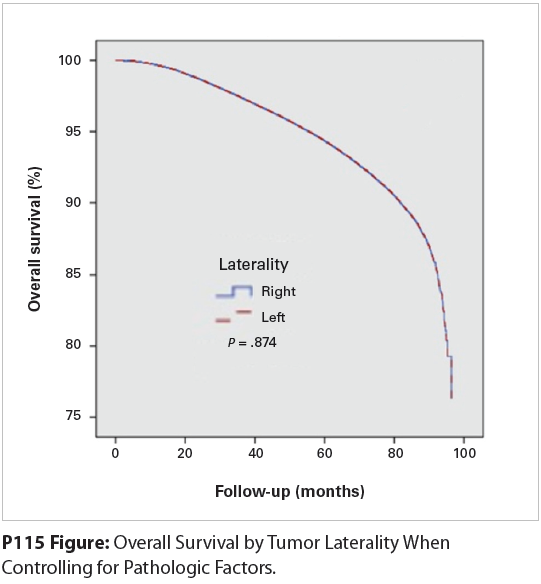(P115) Breast Cancer Laterality Does Not Influence Overall Survival in a Large Modern Cohort: Implications for Radiation-Related Cardiac Mortality
Radiotherapy for left-sided breast cancer has historically been associated with an elevated risk of cardiac mortality, based upon studies in the era predating computed tomography (CT)-based treatment planning. This study assessed the impact of tumor laterality on overall survival (OS) in a large cohort treated with modern techniques to determine if left-sided treatment is still associated with a heightened risk of cardiac mortality.
P115: Figure

Charles E. Rutter, MD, Amy Moreno, Shane Lloyd, MD, Anees Chagpar, MD, Suzanne B. Evans, MD; Yale–New Haven Hospital
Objectives: Radiotherapy for left-sided breast cancer has historically been associated with an elevated risk of cardiac mortality, based upon studies in the era predating computed tomography (CT)-based treatment planning. This study assessed the impact of tumor laterality on overall survival (OS) in a large cohort treated with modern techniques to determine if left-sided treatment is still associated with a heightened risk of cardiac mortality.
Methods: Patients treated for breast cancer with breast-conserving surgery and adjuvant external beam radiotherapy were identified in National Cancer Database (NCDB), a prospectively maintained nationwide database. Overall survival (OS) was compared based upon tumor laterality using Kaplan-Meier analysis. Separate analyses were performed for patients with noninvasive and invasive carcinoma, as well as patients treated with breast-only radiotherapy and breast plus regional nodal radiotherapy. Multivariate Cox regression analysis of OS was performed with age, estrogen receptor status, American Joint Committee on Cancer (AJCC) stage group, tumor grade, Charlson/Deyo comorbidity score, adjuvant chemotherapy or endocrine therapy receipt, and tumor laterality as covariates.
Results: We identified 344,831 patients treated between 1998 and 2006 for noninvasive (12.1%) and invasive carcinoma (87.9%), with a median follow-up of 72.5 months (range: 0–170 mo) in the overall cohort. Clinical, tumor, and treatment characteristics of patients with left-sided cancers (50.7%) closely matched those of patients with right-sided cancers. Regional nodal radiation was employed in 14.2% of patients treated for invasive cancer. No difference in OS was noted when comparing patients by tumor laterality for patients treated with breast-only radiotherapy (hazard ratio [HR] = 0.984; 95% confidence interval [CI], 0.965–1.005; P = .132), as well as for invasive carcinoma treated with breast and regional nodal radiotherapy (HR = 1.001; 95% CI, 0.959–1.045; P = .957). In multivariate analysis including potential confounders of a potential OS-by-laterality effect, OS was identical between left- and right-sided cancers (Figure; HR = 1.002; 95% CI, 0.973–1.032; P = .874). When analyzing patients with at least 10 years of follow-up (n = 27,725), it remained that there was no significant difference in OS by laterality, both in patients treated with breast-only (HR = 0.955; 95% CI, 0.863–1.056; P = .368) and breast plus regional nodal radiotherapy (HR = 0.859; 95% CI, 0.668–1.080; P = .155).
Conclusions: Treatment of left-sided invasive and noninvasive breast cancer with radiotherapy does not appear to increase the risk of death in this large prospective national database relative to right-sided tumors. Consequently, radiotherapy delivered in a modern fashion using CT planning may not increase the risk of cardiac mortality.
Newsletter
Stay up to date on recent advances in the multidisciplinary approach to cancer.